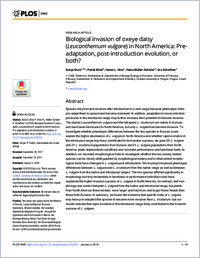Biological invasion of oxeye daisy (Leucanthemum vulgare) in North America: Pre-adaptation, post-introduction evolution, or both?
- Stutz, Sonja CABI, Delémont, Switzerland - Department of Biolog, Ecology & Evolution, University of Fribourg, Switzerland
- Mráz, Patrik Herbarium and Department of Botany, Charles University in Prague, Czech Republic
- Hinz, Hariet L. CABI, Delémont, Switzerland
- Müller-Schärer, Heinz Department of Biolog, Ecology & Evolution, University of Fribourg, Switzerland
- Schaffner, Urs CABI, Delémont, Switzerland
-
04.01.2018
Published in:
- PLOS ONE. - 2018, vol. 13, no. 1, p. e0190705
English
Species may become invasive after introduction to a new range because phenotypic traits pre-adapt them to spread and become dominant. In addition, adaptation to novel selection pressures in the introduced range may further increase their potential to become invasive. The diploid Leucanthemum vulgare and the tetraploid L. ircutianum are native to Eurasia and have been introduced to North America, but only L. vulgare has become invasive. To investigate whether phenotypic differences between the two species in Eurasia could explain the higher abundance of L. vulgare in North America and whether rapid evolution in the introduced range may have contributed to its invasion success, we grew 20 L. vulgare and 21 L. ircutianum populations from Eurasia and 21 L. vulgare populations from North America under standardized conditions and recorded performance and functional traits. In addition, we recorded morphological traits to investigate whether the two closely related species can be clearly distinguished by morphological means and to what extent morphological traits have changed in L. vulgare post-introduction. We found pronounced phenotypic differences between L. vulgare and L. ircutianum from the native range as well as between L. vulgare from the native and introduced ranges. The two species differed significantly in morphology but only moderately in functional or performance traits that could have explained the higher invasion success of L. vulgare in North America. In contrast, leaf morphology was similar between L. vulgare from the native and introduced range, but plants from North America flowered later, were larger and had more and larger flower heads than those from Eurasia. In summary, we found litte evidence that specific traits of L. vulgare may have pre-adapted this species to become more invasive than L. ircutianum, but our results indicate that rapid evolution in the introduced range likely contributed to the invasion success of L. vulgare.
- Faculty
- Faculté des sciences et de médecine
- Department
- Département de Biologie
- Language
-
- English
- Classification
- Biological sciences
- License
- License undefined
- Identifiers
-
- RERO DOC 306706
- DOI 10.1371/journal.pone.0190705
- Persistent URL
- https://folia.unifr.ch/unifr/documents/306318
Statistics
Document views: 99
File downloads:
- mue_bio.pdf: 153
